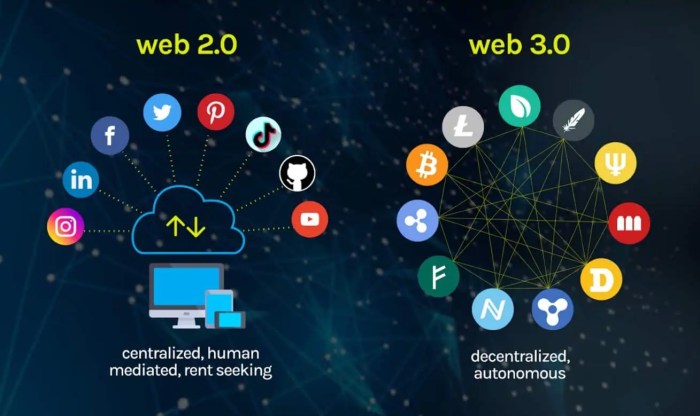The impact of Web3 on the future of the internet – Web3: Shaping the Internet’s Future – Imagine a world where you own your data, control your identity, and participate in a decentralized, transparent, and user-centric online experience. That’s the promise of Web3, a revolution that’s poised to rewrite the rules of the internet as we know it.
This shift from the centralized web to a decentralized ecosystem is fueled by blockchain technology, creating a new landscape where users are empowered and applications are built on trust.
From decentralized finance (DeFi) that empowers individuals to manage their finances without intermediaries to non-fungible tokens (NFTs) that redefine digital ownership and content creation, Web3 is already impacting various industries. But the implications extend far beyond these early examples.
This technology has the potential to transform how we interact with the internet, how we create and consume content, and even how we build and manage our online communities.
Introduction to Web3

The internet has undergone a remarkable evolution, transitioning from a static web of information (Web1) to a dynamic platform for user interaction (Web2). Now, we stand at the cusp of a new era, Web3, promising a decentralized, user-centric, and transformative experience.
Web3 represents a paradigm shift in how we interact with the internet, empowering users with ownership and control over their data, applications, and digital assets. It is a decentralized ecosystem built on blockchain technology, fostering transparency, security, and a more equitable digital landscape.
Core Principles of Web3
The core principles of Web3 are the foundation of its revolutionary nature:
- Decentralization:Power is distributed across a network of users, eliminating reliance on centralized entities like corporations or governments. This fosters greater autonomy and reduces vulnerabilities to censorship or single points of failure.
- Transparency:All transactions and data are recorded on a public, immutable ledger, ensuring accountability and traceability. This fosters trust and allows users to verify information independently.
- User Ownership:Users have control over their data and digital assets, eliminating the need for intermediaries. This fosters a more equitable digital economy, where users are not beholden to platforms or corporations for access to their own information.
Evolution of the Internet
The internet has evolved through distinct phases:
- Web1 (1990s-early 2000s):This era was characterized by static websites, primarily used for information dissemination. Users were passive consumers, with limited interaction and ownership.
- Web2 (early 2000s-present):The rise of social media, e-commerce, and cloud computing marked Web2. User interaction became central, but platforms controlled data and user experience. While this brought benefits, it also raised concerns about privacy and data exploitation.
- Web3 (present and beyond):Web3 represents a paradigm shift towards a decentralized internet, empowering users with ownership and control. Blockchain technology underpins this transition, enabling secure and transparent transactions, fostering a more equitable digital landscape.
Real-World Applications of Web3 Technologies
Web3 technologies are already transforming various industries, with applications ranging from finance to art and governance:
- Decentralized Finance (DeFi):This sector leverages blockchain technology to offer financial services like lending, borrowing, and trading without intermediaries. Platforms like Aave and Compound allow users to access financial services with greater transparency and control.
- Non-Fungible Tokens (NFTs):NFTs are unique digital assets that represent ownership of digital or physical items. They have gained prominence in the art world, allowing artists to sell and monetize their work directly, eliminating the need for galleries or intermediaries. The NFT market has also extended to other sectors, including gaming, music, and collectibles.
- Decentralized Autonomous Organizations (DAOs):DAOs are community-owned and governed organizations that operate on blockchain technology. They allow for transparent decision-making, enabling members to participate in governance and share in the organization’s success. Examples include Uniswap, a decentralized exchange, and MakerDAO, a stablecoin platform.
Impact on User Experience
The Web3 revolution promises a user experience that’s more empowering, secure, and personalized than ever before. This shift in power dynamics stems from the fundamental principles of Web3, which prioritize user ownership and control over data, identity, and online interactions.
The Rise of User Control
Web3 empowers users with greater control over their data and identity. This is a stark contrast to the centralized web, where user data is often collected, stored, and used by large corporations without their consent. In Web3, users have the power to manage their data, decide who has access to it, and even monetize it if they choose.
This shift in ownership and control creates a more equitable and empowering online environment.
The Role of Blockchain Technology
Blockchain technology plays a crucial role in enhancing security and privacy in Web3. Blockchain’s decentralized nature ensures that user data is not stored in a single location, making it more resistant to breaches and hacks. Additionally, blockchain’s transparent and immutable ledger allows users to track their data and ensure its integrity.
“Blockchain technology is the backbone of Web3, enabling secure and transparent data management. It’s like a digital vault that protects user data and empowers them to take control of their online experience.”
Examples of Web3 Platforms
Web3 platforms are emerging across various sectors, offering a more personalized and user-centric experience. For example, decentralized social media platforms like Minds and Diaspora give users greater control over their content and data. Decentralized finance (DeFi) platforms like Uniswap and Aave allow users to manage their finances without relying on traditional financial institutions.
These platforms demonstrate the potential of Web3 to revolutionize user experiences across different industries.
The Rise of Decentralized Applications (DApps): The Impact Of Web3 On The Future Of The Internet

Imagine a world where apps aren’t controlled by big tech giants, but by the people who use them. This is the promise of decentralized applications, or DApps, a key component of Web3. DApps run on blockchain networks, making them resistant to censorship and transparent in their operations.
DApps vs. Traditional Apps
DApps differ from traditional apps in their fundamental architecture and operation. Traditional apps rely on centralized servers owned by companies, giving them control over the app’s data, features, and user experience. DApps, on the other hand, operate on decentralized networks like Ethereum, where the code is open-source and accessible to everyone.
This means that no single entity controls the app, making it more resilient to censorship and manipulation.
Benefits of DApps
DApps offer several advantages over traditional apps:
- Censorship Resistance:DApps are immune to censorship because their code is open-source and runs on a decentralized network. This means that no single entity can shut down or alter the app, ensuring freedom of expression and access.
- Transparency:DApps are built on blockchain technology, which provides a permanent and immutable record of all transactions. This transparency fosters trust and accountability, allowing users to track the app’s operations and data flow.
- Security:DApps leverage cryptography and decentralized consensus mechanisms to ensure security and prevent fraud. This makes them more resistant to hacking and data breaches compared to traditional apps.
- User Ownership:DApps empower users by giving them control over their data and digital assets. This fosters a more equitable and user-centric internet experience.
Examples of Successful DApps
DApps are emerging across various industries, demonstrating their potential to revolutionize how we interact with technology.
- Gaming:Decentralized gaming platforms like Axie Infinity allow players to own and trade in-game assets, creating a more immersive and rewarding experience. Players can earn cryptocurrency by playing, fostering a new economic model within the gaming industry.
- Finance:Decentralized finance (DeFi) platforms like Aave and Compound enable users to lend, borrow, and trade cryptocurrencies without intermediaries, offering greater control and transparency compared to traditional financial institutions.
- Social Media:Decentralized social media platforms like Minds and Steemit give users ownership of their data and content, fostering a more equitable and censorship-resistant online environment.
The Future of Content Creation and Distribution
Web3 promises to reshape the landscape of content creation and distribution, shifting power back to creators and fostering a more equitable and decentralized ecosystem. By leveraging blockchain technology and decentralized platforms, Web3 enables creators to retain ownership and control over their work, opening up new avenues for monetization and direct engagement with their audiences.
The Potential of NFTs in Supporting Artists and Creators, The impact of Web3 on the future of the internet
Non-fungible tokens (NFTs) have emerged as a powerful tool for empowering artists and creators in the Web3 era. NFTs represent unique digital assets, providing verifiable ownership and provenance for digital content. They allow creators to sell their work directly to collectors, bypassing traditional intermediaries and capturing a larger share of the revenue.
NFTs can be used to represent a wide range of digital assets, including music, art, videos, and even virtual experiences.
- By minting their work as NFTs, creators can create scarcity and value, allowing them to charge higher prices and build a loyal following.
- NFTs also enable creators to build direct relationships with their fans, offering exclusive content, access to community events, and even voting rights on future projects.
Economic Implications of Web3
Web3 is poised to fundamentally alter the way we interact with the internet and, by extension, the global economy. Its decentralized nature and reliance on blockchain technology challenge traditional economic models, opening up new avenues for value creation and distribution.
This section explores the profound economic implications of Web3, focusing on the rise of decentralized finance (DeFi) and the role of tokens and cryptocurrencies in the emerging Web3 economy.
Decentralized Finance (DeFi)
Decentralized finance (DeFi) is a rapidly evolving sector within Web3 that aims to provide financial services without the need for intermediaries like banks or other centralized institutions. DeFi platforms leverage blockchain technology to enable peer-to-peer lending, borrowing, trading, and other financial activities in a transparent and accessible manner.
Impact on Traditional Banking
DeFi platforms offer a range of services that are traditionally provided by banks, including lending, borrowing, and trading. DeFi protocols allow users to earn interest on their cryptocurrency holdings by lending them to others, while borrowers can access loans without the need for a credit check or other traditional banking requirements.
DeFi is disrupting the traditional banking sector by:
- Increased accessibility:DeFi platforms are accessible to anyone with an internet connection, regardless of their location or credit history. This opens up financial services to a wider range of individuals and communities that may be excluded from traditional banking systems.
- Lower costs:DeFi platforms can operate with significantly lower overhead costs than traditional banks, leading to lower fees for users.
- Transparency and security:Blockchain technology ensures transparency and security in DeFi transactions, reducing the risk of fraud and manipulation.
Examples of DeFi Applications
* Lending and Borrowing:Platforms like Aave and Compound allow users to lend and borrow cryptocurrencies, earning interest on their deposits or accessing loans at competitive rates.
Stablecoins
Stablecoins, such as Tether (USDT) and USD Coin (USDC), are cryptocurrencies pegged to the value of fiat currencies like the US dollar. They provide a stable store of value and facilitate price stability within DeFi ecosystems.
Decentralized Exchanges (DEXs)
DEXs like Uniswap and SushiSwap allow users to trade cryptocurrencies directly with each other without the need for a centralized exchange. This provides greater privacy and control over users’ funds.
Tokens and Cryptocurrencies in the Web3 Economy
Tokens and cryptocurrencies are integral to the functioning of the Web3 economy. They serve as a medium of exchange, a store of value, and a mechanism for governance and participation in decentralized networks.
Types of Tokens
Tokens can be broadly categorized into two types:
- Utility Tokens:These tokens provide access to a specific service or platform. For example, a platform for streaming music might issue a utility token that users can use to purchase music or unlock premium features.
- Security Tokens:These tokens represent ownership in a company or asset.
They can be used to raise capital for projects or to provide investors with voting rights and other benefits.
Role of Tokens in Web3
Tokens play a crucial role in facilitating the decentralized nature of Web3:
- Decentralized Governance:Many Web3 projects use tokens to allow users to participate in governance decisions. Token holders can vote on proposals related to the project’s development, future direction, and resource allocation.
- Incentivization:Tokens can be used to incentivize users to participate in a network or platform.
For example, users might be rewarded with tokens for contributing content, providing liquidity, or completing tasks.
- Value Creation:Tokens can represent ownership in a project or asset, enabling the creation of new forms of value.
Social and Ethical Considerations
Web3’s potential to revolutionize the internet extends beyond technological advancements; it also presents a unique set of social and ethical considerations. While promising increased accessibility and empowerment, Web3 technologies also introduce challenges related to data privacy, security, and responsible development.
Impact on Accessibility and Empowerment
The decentralized nature of Web3 fosters a more inclusive and accessible internet by removing barriers imposed by centralized entities. This empowers individuals and communities, allowing them to participate in the digital economy and control their data more effectively.
- Decentralized Finance (DeFi):DeFi platforms provide access to financial services, such as lending and borrowing, without relying on traditional intermediaries. This can benefit underserved communities who may lack access to traditional banking systems. For instance, in developing countries where financial infrastructure is limited, DeFi platforms can offer alternative means of accessing financial services.
- Decentralized Autonomous Organizations (DAOs):DAOs allow for the creation of transparent and democratic organizations, giving individuals a voice in decision-making processes. This empowers individuals to participate in governance and ownership of projects, fostering a more equitable and collaborative environment. For example, a DAO dedicated to promoting open-source software development could allow community members to contribute to decision-making and share in the project’s success.
- Data Ownership and Control:Web3 technologies, such as blockchain and decentralized storage, enable individuals to own and control their data. This empowers individuals to decide how their data is used and shared, reducing the reliance on centralized platforms that often control and monetize user data.
For example, users could choose to share their data with specific applications or services while maintaining control over its usage and sharing.
Ethical Challenges
While Web3 offers exciting possibilities, it also presents ethical challenges that require careful consideration and responsible development.
- Data Privacy and Security:Decentralization can make it challenging to ensure data privacy and security. While Web3 technologies offer potential for greater data control, the decentralized nature of the network can also make it more vulnerable to attacks. For example, a malicious actor could exploit vulnerabilities in a decentralized storage network to access sensitive data.
Browse the implementation of Create mindful and intentional lifestyle for a fulfilling life in real-world situations to understand its applications.
- Accessibility and Inclusivity:While Web3 aims to promote accessibility, it’s crucial to ensure that its benefits are available to all. The complexity of Web3 technologies and the potential for digital divides could create barriers for individuals with limited access to technology or digital literacy.
For example, a lack of access to high-speed internet or a lack of understanding of blockchain concepts could hinder participation in Web3 platforms.
- Sustainability and Environmental Impact:The energy consumption associated with blockchain technologies, particularly proof-of-work consensus mechanisms, raises concerns about sustainability and environmental impact. While research and development are ongoing to address these concerns, it’s crucial to ensure that Web3 technologies are developed and adopted responsibly.
For example, exploring alternative consensus mechanisms, such as proof-of-stake, that consume less energy could mitigate the environmental impact.
Promoting Responsible Development
To mitigate potential risks and ensure the ethical development and adoption of Web3, several initiatives are underway:
- Open Source Development:Encouraging open-source development promotes transparency and collaboration, allowing for community scrutiny and improvement of Web3 technologies. Open-source projects can benefit from contributions from a diverse range of developers, fostering innovation and addressing potential vulnerabilities.
- Education and Awareness:Raising awareness about Web3 technologies and their implications is crucial for promoting responsible adoption. Educational initiatives can empower individuals to understand the benefits and challenges of Web3, enabling them to make informed decisions and participate actively in its development.
For example, educational programs could focus on explaining blockchain concepts, data privacy, and security considerations associated with Web3 technologies.
- Regulation and Governance:Establishing clear regulations and governance frameworks for Web3 technologies is essential for ensuring responsible development and addressing ethical concerns. This can help to mitigate risks, protect users, and promote innovation within a responsible framework. For example, regulatory frameworks could address data privacy, security standards, and responsible use of Web3 technologies.
Challenges and Opportunities for Web3 Adoption
Web3, with its promise of a decentralized and user-controlled internet, faces significant challenges in its journey to widespread adoption. However, these challenges also present exciting opportunities for innovation and growth, paving the way for a truly transformative digital future.
Scalability and Performance
Web3 applications, especially those built on blockchains, often struggle with scalability and performance limitations. The processing power required to handle large transaction volumes can lead to slow transaction speeds and high fees, hindering user experience.
- Transaction throughput:Many blockchains, particularly those using Proof-of-Work consensus mechanisms, can only handle a limited number of transactions per second, leading to congestion during peak periods. This can result in delayed transactions and increased fees.
- High gas fees:The cost of executing transactions on blockchains, known as gas fees, can be prohibitively high, especially for users with limited financial resources. This can limit access to Web3 applications for a significant portion of the population.
Security and Privacy
The decentralized nature of Web3 presents both opportunities and challenges in terms of security and privacy. While decentralization can enhance security by removing single points of failure, it also introduces new vulnerabilities, such as smart contract security flaws and the risk of phishing attacks.
- Smart contract vulnerabilities:Smart contracts, the building blocks of Web3 applications, can be susceptible to security flaws that can be exploited by malicious actors. This can lead to financial losses and damage to the reputation of the application.
- Data privacy concerns:Web3 applications often collect and store user data on blockchains, which are public and immutable. This raises concerns about data privacy and the potential for misuse of personal information.
User Friendliness and Accessibility
Web3 technologies are still relatively complex and require a certain level of technical knowledge to use effectively. This can be a barrier to entry for many users, especially those who are not familiar with concepts such as cryptocurrency, wallets, and decentralized applications.
- Complexity of wallets and keys:Managing cryptocurrency wallets and private keys can be challenging for new users, particularly those unfamiliar with traditional financial systems. This can lead to errors and security risks, hindering adoption.
- Lack of user-friendly interfaces:Many Web3 applications have user interfaces that are not as intuitive or user-friendly as traditional web applications. This can make it difficult for users to navigate and interact with the application, discouraging adoption.
Regulation and Governance
The decentralized nature of Web3 presents unique challenges for regulation and governance. Traditional regulatory frameworks are often ill-equipped to address the complexities of blockchain technology and its applications.
- Lack of clear regulatory frameworks:The lack of clear regulatory frameworks for Web3 can create uncertainty for businesses and developers, hindering innovation and investment. This can also create legal and ethical dilemmas for users.
- Governance challenges:Decentralized governance models, while promoting transparency and community participation, can also lead to challenges in decision-making and conflict resolution. This can impact the development and sustainability of Web3 projects.
Conclusive Thoughts
Web3 isn’t just a technological advancement; it’s a paradigm shift that’s fundamentally altering the relationship between users and the internet. As we navigate the evolving landscape of Web3, it’s crucial to understand its potential benefits, address its challenges, and embrace the opportunities it presents.
This new era of the internet promises a more equitable, transparent, and user-centric experience, where the power rests in the hands of the people. While challenges exist, the future of the internet looks bright, and Web3 is the key that unlocks its potential.
Q&A
What are some real-world examples of Web3 applications?
Beyond DeFi and NFTs, Web3 is finding its way into various sectors, such as gaming (e.g., Axie Infinity, The Sandbox), social media (e.g., Minds, Diaspora), and even supply chain management (e.g., Provenance, VeChain). These examples demonstrate the diverse applications of Web3 technology and its potential to revolutionize various industries.
What are the key challenges facing Web3 adoption?
While Web3 holds great promise, its widespread adoption faces several challenges. These include the complexity of the technology for average users, the need for better infrastructure and scalability, and the regulatory uncertainty surrounding cryptocurrencies and decentralized applications.
 CentralPoint Latest News
CentralPoint Latest News




